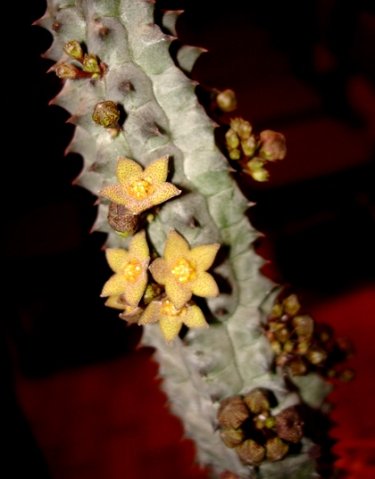Richtersveldia columnaris

Author: Ivan Lätti
Photographer: Judd Kirkel Welwitch
Richtersveldia columnaris, previously known as Notechidnopsis columnaris and earlier as Trichocaulon columnare, is a stem succulent that forms a clump of cylindrical stems, occasionally reaching 30 cm in height.
The stems become slightly over 2 cm thick, sometimes tapering slightly at both ends. Branching at the base, the sometimes tortuous stems are up to eight-angled, their acutely pointed tubercles growing in neat columns, tessellated like square tiles or mosaic.
The flower buds are dark and cone-tipped, emerging in fascicles of up to 15 on the upper halves of the stems. In the open flower the small, yellowish corolla with scattered purple-red spots has a five-pointed star-shape. Its ovate lobes are hairy and tapering to acute tips that may recurve slightly. The outer corona has five linear yellow lobes, sometimes purple-spotted. The inner corona lobes are 2 mm long, yellow with purple-red dots, positioned over the anthers, but leaving a tiny opening in the centre. Flower diameter is about 7 mm. The plant in picture was found flowering in October.
The species is endemic to the central and north-western Richtersveld where it grows fairly high up on the mountains. It is typically found on steep, rocky slopes or stony brows in short scrub, growing under bushes or between rocks. The species is considered to be vulnerable in its habitat early in the twenty first century, being both range-restricted and subject to illegal plant collection. Habitat degradation from overgrazing occurs and the species population is decreasing, although the species itself is not grazed (Williamson, 2012; White and Sloane, 1973; iSpot; www.redlist.sanbi.org).

